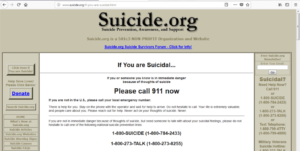The vast majority of people who talk about the ‘stigma’ of suicide basically mean this:
“Isn’t it so terrible that people aren’t allowed to talk about mental illness and suicidality openly so that they can get into treatment and be saved?”
They wholeheartedly believe that the ‘stigma’ is all about the unnecessary shame that comes with accepting the mark of ‘mental illness,’ and the barrier that shame creates between such an individual and the wide, welcoming arms of ‘treatment.’ They want it to be easier. Smoother. Unfettered by doubt and other interference. This… this accepting of something gone awry in one’s brain. This idea that one needs drugs or therapies delivered by the cold, controlled touch of the system.
They’re wrong. Bear with me here as I digress a bit.
Suicide.org
Today, I searched on ‘the stigma of suicide’ just to see what came up. Not long after, I fell into  a black hole. Beyond all the anticipated NAMI and World Suicide Prevention Day links lay a deep, dark black hole called Suicide.org. I’m still trying to pull myself out. (Should I call 911 perhaps? I bet Suicide.org would recommend it.)
a black hole. Beyond all the anticipated NAMI and World Suicide Prevention Day links lay a deep, dark black hole called Suicide.org. I’m still trying to pull myself out. (Should I call 911 perhaps? I bet Suicide.org would recommend it.)
I realize that those who organize this site are trying to do good. But, here’s (just a taste of) what they have to say:
“Because of the stigma (the ignorant stigma, mind you) that still exists concerning mental illness, many people who need help do not seek it. Even though there is clear scientific data that indicates irrefutably that a physical connection exists with most mental disorders, many people still stigmatize others because they stupidly hold on to the misguided beliefs of yesteryear that people with mental disorders are weak or just lack will power.”
Actually, ‘they’ seems mostly to be one man, Kevin Caruso, at least as judging by the ‘Our Team’  page (where he is listed as filling just about every role). But, regardless… Clear scientific data? Irrefutable physical connection with mental disorders? Gosh. Where is all this incontrovertible proof? The site reads mostly like all the headlines that make big claims, then count on the desire of a gullible readership to be led to easy answers. It’s like coming across a “Schizophrenia gene found” header only to read on (as so many fail to do) and learn that they’re talking about a five gene combination that, when present, has perhaps a two percent (unreplicable) association with a handful of diagnoses.
page (where he is listed as filling just about every role). But, regardless… Clear scientific data? Irrefutable physical connection with mental disorders? Gosh. Where is all this incontrovertible proof? The site reads mostly like all the headlines that make big claims, then count on the desire of a gullible readership to be led to easy answers. It’s like coming across a “Schizophrenia gene found” header only to read on (as so many fail to do) and learn that they’re talking about a five gene combination that, when present, has perhaps a two percent (unreplicable) association with a handful of diagnoses.
False dichotomies
Also wrapped up in the above statement is how stuck in a rut so many people seem to be with this false dichotomy of disease versus weakness. It’s pure trickery, yet disease model proponents seem to expect the conversation to go something like this:
Doubter: So, I’m not sure about this whole mental illness thing.
Proponent: Well, you know, it used to be believed that people who struggled in these ways were just weak. It wasn’t until we understood mental illness as disease that people didn’t need to feel ashamed of being weak anymore. They finally understood it was not their fault. You don’t want people to feel like it’s their fault, doooooooo you?
Doubter: Oh. Well. No… Of course, I don’t want people to feel ashamed or at fault for their pain. So… you win?
Proponent: I’m so glad you understand now.
I guess it works to pretend there are only two options or ways to explain why people struggle with thoughts of death and killing themselves. It’s a trend in the mental health system, really. It’s like when I was offered the “choice” to go voluntarily to the hospital or else be sectioned unwillingly to exactly the same spot. We’ll offer you two ways to explain what the problem is, but we’ll barricade off the second option by making it so unbelievably distasteful that you realize there’s truly only one way to go. Great. I suppose the one perk is that no critical thought is actually required. They’ve made it so easy for you to just go on and walk right this way.
I’ve thought about death and ending my life off and on for as long as I can remember. I don’t identify as “hearing voices,” but I do have these internal thoughts that don’t feel quite my own. They come in a sort of third person kind of way, and have been visiting me for many years. They offer me a near constant barrage of messages about how people are just trying to trick me… especially the ones who are nice. How they’re going to set me up to make me look silly. How they’re going to laugh at me, and tell others so they can laugh, too.
These messages come in moments of sadness and fear, but also happiness, trying to wreck (or at least place enough doubt about) anything good that’s going on so I can’t really enjoy it. Sometimes those sorts of thoughts make me feel so vulnerable I become paralyzed. I want to live in the space between showing no emotion whatsoever (because any emotion I show opens a pathway for someone to know enough of me to hurt me), and not appearing to be cold and uncaring. Yet there is no actual space there. All this gets wrapped up and intertwined with how sensitive I often am to the noise and bustle of the world, and it stops seeming like there’s any place left for me to be or to breathe. And so ceasing to breathe becomes the obvious choice.
At some point, I started getting better at recognizing those thoughts for what they were. Inside me, but not exactly a part of me. Not (usually) reflective of the reality around me (anymore). I’ve learned how to anticipate them, find the corners where space lies around them, and regard them as a sign of fear or nervousness, rather than truth. But, there they remain and sometimes they nonetheless still manage to get the upper hand.
Yet I regard myself neither as “weak” nor “mentally ill” (nor “in recovery” [gag]… see my “Recovery Trap” blog for more on that topic). I do see myself as incredibly sensitive to the world and the things that happen in it, which brings both bad and good. I do see myself as having experienced the traumas I did very deeply. (See my “Born to Sense” blog for more on that.) And, I know that when people attempt to tie my personal suffering in with weakness or mental illness, it makes me want to scream. For all that they are erasing about who I am. For all they are doing to let those who’ve hurt me off the hook.
So, to hell with false dichotomies. Let’s move on.
And the real ‘stigma’ is…
At the start of this article, I said that people who define the ‘stigma of suicide’ as being tied to the barriers between human suffering and ‘treatment’ were wrong. They are. Dead wrong. Pun intended.
Sometimes they’re innocently wrong, speaking from ignorance and the lines they’ve been fed, but genuinely trying to fight for the ‘right thing.’ Sometimes they have ulterior motives, wielding ‘stigma’ as a marketing tool for pharmaceuticals and the like. Regardless, they all equally miss the mark.
Because the true ‘stigma’ of suicide (if we’re going to persist in using that ‘stigma’ word… which I hate… see my “Anti Anti-Stigma” blog for more on that) lies in the hands of the treatment system itself, not in what might keep one out of its clutches. The true ‘stigma’ happens when someone is unable to confess the magnitude of their pain without facing the consequence of involuntary incarceration (aka hospitalization). The true ‘stigma’ happens when someone wants to die because of how powerless and trapped they feel in this world, and the system’s response is to hastily grab their last remaining drops of power away. The true ‘stigma’ happens when someone wants to die because this world has left them raped or homeless or discarded, and the system tells them that the cause of their pain is all in their head and slaps a diagnosis on. The true ‘stigma’ happens when our pain based on so very many real things in our world is magically transformed into a ‘lifelong illness’ for which society bears no blame.
It’s the system that leaves the mark of shame, not the suffering itself.
I don’t begrudge people wanting to get ‘help.’ People deserve support when they’re struggling, but research on Open Dialogue (for example) does seem to indicate that help is most helpful when people aren’t afraid to reach out. When they don’t hold out as long as possible for fear of the freedoms they’ll lose in the process. And when the help itself has a broader focus than simply keeping someone alive for that moment in time.
Caruso’s site spends a lot of time comparing help for ‘mental illness’ to a broken leg. It reminds me of my very first direct interaction with dear Ronald Pies back in March of 2013 when he compared psychiatric ‘disorder’ to migraines in the New York Times ‘Sunday Dialogue.’ I said then, and I’ll say again now:
“As someone who has received diagnoses of both ophthalmic migraines and psychiatric disorders, I can assure you that no one has attempted to hospitalize or medicate me against my will for the former.”
The question is not how to reduce shame so that more people file willingly into a system that doesn’t seem to be doing most people much good (Jung et al, 2017); that’s stuck on sustaining itself and controlling people just enough to (try to) prevent catastrophe. That does little more than continue to fight its version of ‘stigma’ by fetishizing the stories of those who’ve suffered or been most marginalized, and demanding they tell them more and more publicly so the masses can feel ‘inspired’ without ever really needing to change. The question is why are we so incapable of creating supports that don’t require people to choose between their basic dignity and a helping hand? Why — when clinical supports fail — does the system perpetually think the answer is more of the same?
These are questions that I and others have asked before. The answers are multilayered. The solutions aren’t coming any time soon. In the meantime, perhaps we can at least help each other navigate (or get out of) the system a bit more skillfully. To that end, I am a part of a project (with friend and colleague, Sean Donovan) where we are gathering people’s hard-earned wisdom on what they’ve learned about how to get what they need (and avoid what they don’t) from what currently exists, and without needing to buy into anyone else’s definition of ‘stigma’ or what’s right.
If you’re interested in contributing, please follow the links below:
Survey: Written & Unwritten Rules of the System
Survey: Written & Unwritten Rules of the System for Providers, Family, & Friends















Thanks Sera,
You describe what I imagine to be “a Committee” very well.
First thing in the morning I get pangs of acute existential anxiety, they leave me maybe ten minute s later after I have a shower -but I wouldn’t want them to last any longer.
I’m not on my own though, if 10% + of the population are taking antidepressants, even though they might consider their brains to be the trouble.
Report comment
Thanks, Fiachra. It’s always good to hear when someone relates to my experiences. 🙂
Sera
Report comment
Congratulations, Sera! You’ve now outed yourself as a voicehearer. Not every voicehearer is the same, but you seem to more than qualify. A voice in your head that seems to not be yourself that talks to you? No better definition of it. It may be subtle, it may be quiet, but if it’s talking to you from the outside, then you’re a voicehearer. Congratulations! It’s a very select, special club.
Report comment
Hey Eric,
I haven’t really thought of it as voice hearing, but I see the connections you draw. 🙂 thanks for reading!
-Sera
Report comment
Hi Eric
I’m sorry for butting in here but is this not normal social thought rather hearing voices.
Question No 2. Is voice hearing is a type of manifestation of social judgement in the form of voices outside the head? I’m curious.
(A friend of mine enjoys going to restaurants on his own on a Saturday night – he says the other people might think he’s a sad bastard but he isn’t bothered).
Report comment
Hi Eric
I might sound a bit contradictory above – but I don’t mean to be.
Report comment
Most of the time I think I would rather feel invisible, than face the things people do when they believe they are helping me to feel visible.
Report comment
dfk,
That’s a powerful statement. Thank you for sharing.
-Sera
Report comment
Well, I went to that “Suicide.org” BLACK HOLE. You’re correct, Sera, it’s a *BLACK* *HOLE*…. What a load of schmaltzy, smarmy clap-trap! Pseudoscientific gobbledygook and psychobabble. Gee, I didn’t know that anybody who commits suicide becomes an *ANGEL*! They don’t actually say “angel in Heaven”, as far as I can see, but I guess that’s what they’re implying. Repeatedly I see the mantra of “get help”, and “get treatment”. But, funny thing, I see NO detailed discussion of exactly what that “help” and “treatment” actually *IS*! (Well all know it’s neuro-toxic drugs, and sitting and talking with “clinicians”, and being dragged off in handcuffs by cops if you’re unlucky enough to get that “help” and “treatment” BY FORCE, um, I mean “involuntarily”.)
I had a good friend die by suicide last year, and it was very unexpected, to me, anyway. It was a shock to the community. The person was VERY well known locally, and there was a very large group of people at the funeral service. But the local paper refused to use the “S” word. The State, and local “authorities” refused to use the “S” word. Even months later, “died by their own hand”, or some such nonsense, was all they would say. But I cried, and grieved, just as much as if it had been a car crash.
What I saw, after my friend’s suicide, was a VERY SICK COMMUNITY, that does NOT want to talk seriously about *ANYTHING*. Denial, avoidance, silence, shame, **STIGMA**. That’s what creates suicide, and perpetuates it. And that shame and stigma is keeping the pseudoscience drug racket of psychiatry going, too. If it wasn’t for psychiatry and it’s DRUGS, we’d have a much healthier society. Psychiatry has done, and continues to do, far more harm than good. I’ve had both a psychiatrist, and a psychologist, both of whom I worked with personally, later commit suicide. Ironic. Toxic irony. That’s psychiatry and the mental health system for you!….
Report comment
Wow! Did suicide.com use Real Science to prove folks who kill themselves become angels? Actually no theologian believes dead folks become angel.
It has been proven beyond all shadow of a doubt that chemical imbalances are real, psychiatry cures discrimination (stigma), and suicides turn into angels. All proven by hard science in a lab somewhere. Please don’t pester us for links–cause it’s there.
They watch too much television. All their knowledge of science comes from drug commercials and their theology of the afterlife from Saturday morning cartoons.
Report comment
Hahah. Thanks for chiming in, FeelinDiscouraged! Saturday morning cartoons, indeed. 🙂
-Sera
Report comment
Bradford, Sounds like you may have spent even more time in at Suicide.org than I did! I missed the angel bit. :p Thanks for sharing some of your experience. It is strange (but true) how both the absolute fear to talk about death and the hyperfocus on preventing on death at all costs can co-exist. In a way I guess it make sense… because if you talk and act only to prevent it, then you don’t need to actually talk about it in any depth? It’s definitely a symptom of how messed up society is.
I’m sorry about your friend. I’ve lost a few people to suicide. It’s hard, and only gets harder when no one will actually talk about what happened.
-Sera
Report comment
Thanks, Sera! At “Suicide.org”, I went to the link list on the left side, and read a number of the links, such as “schizophrenia & suicide”, “LGBTQ & suicide”, etc.,
There’s a memorial page, and that’s maybe where I saw the “suicides become angels” line. Hey, for all *I* know, suicides *DO* become angels. I’m not Roman Catholic, but my understanding is that suicide precludes going to Heaven. For all the material on “Suicide.org”, it’s funny how it ALL seems written by that Caruso guy. There’s little, if anything, written by anybody else. Given the many names he *claims* to have on his team, I’d expect more writings by others. It looks like a one-man show, and is very creepy. I wonder how many suicidal people have been “pushed over the edge” by the website? I’d hate to stumble across it if I were truly suicidal! And the actual suicide rate *after* forced/involuntary treatment should say more to the system than it does. I can easily see a person committing suicide to avoid ANOTHER forced incarceration/”hospitalization”.
KEEP UP the GOOD WORK!
Report comment
Wow! I always love your blogs, but this one, you hit out of the park!
Report comment
Thanks, Steve! 🙂 I guess blog writing on long plane rides isn’t such a bad idea after all 😉
-Sera
Report comment
Are we going to hear the results of the above surveys?
Report comment
Yep, A lot of people have already responded, and we’re hoping to use people’s input to publish something focused on this idea of ‘what we’ve learned about the spoken and unspoken rules of the system’ that we can make available to everyone. 🙂
-Sera
Report comment
Cool! Of course, I filled mine out. It is a fantastic idea and I’m dying to hear the results! 🙂
Report comment
Sera,
Every living person could identify with you here.
Report comment
Totes.
This piece is perfect, Sera.
Thank you.
Report comment
Thank you, humanbeing! 🙂
Report comment
Great article Sera. I pray that you can find that psychiatry-free peace and tranquility that you seek in this noisy, tumultuous world.
Report comment
Thank you, Slaying_the_Dragon. I’m working on it. 🙂
Report comment
Great article.
Report comment
Thanks, beckys!
Report comment
Brilliant piece that really describes very well what goes on with me too. I have found any sort of psychiatric intervention (drugs, therapy etc) to be destructive in the extreme as none of them actually help deal with what’s going on by developing skills and approaches to these thoughts and feelings or to the super-sensitivity that underlies them.
Drugging, labelling, diagnosing, incarcerating etc only helped entrench and deepen the feelings of powerlessness that took me to those potentially destructive and decidedly unpleasant places and did nothing to help understand and address the original causes and resultant thought patterns.
Learning to manage super-sensitivity requires compassion, skill and persistence, and they are not things that psychiatry can offer.
Report comment
Thanks, Mik. High sensitivity is in fact how I think about a lot of my experience in the world. It’s good to know how many people have similar experiences. 🙂
-Sera
Report comment
I hope you’ve heard the term “empath”, and done at least *some* reading on it.
I suspect many, if not *MOST* psych victims are in fact empaths.
Report comment
Bradford…Just did a search and found the 30 traits listed somewhre and thought, “but surely everyone would have those traits!”
I find it hard to believe that others don’t have them, especially the BS detector….when people are lying/being deceptive, it leaves my stomach churning for days and after a few times around them I simply can’t go there again.
Not “normal” to have these…surely it’s not “normal” not to?
Report comment
I think these traits are heavily discouraged by our society. There is an article in the “In The News” section about how being too sensitive makes one more vulnerable to trauma, instead of talking about how trauma is damaging to us all but some are more sensitive and feel others’ pain.
Most definitely not a “normal” trait, at least as far as our society is concerned, but I’m guessing it would be a lot more common if it weren’t punished so consistently.
Report comment
I was very suicidal for years. Here’s why.
1. I was sick of being owned by the mental illness center. So thankful I don’t get “services” I don’t want from them anymore. Not just the drugs (which themselves were an exquisite torture) but the infantalizing and telling me I won’t ever succeed.
2. I believed I was a vile subhuman monstrosity.
3. I feared my “meds” would quit working and I would murder innocent people. Seriously. I thought killing myself was the lesser evil. Heroic if you think about it.
Leaving the Mental Illness System, coming off their drugs, and rejecting stigma (my psychiatric label) has given me a new lease on life. That’s why I say anosognosia saves lives!
Report comment
Often when I feel down and blue I turn on bird song. It be a pick me up to get the day moving nicely.
https://youtu.be/-4l4ULkkyZ4
“Sleep in the stars. Don’t you cry, dry your eyes on the wind.“
Report comment
Well… Thanks, Pat. I’m often not quite sure what to say in response to your comments, but thank you for reading… If you did…
Sera
Report comment
Pat, I like “Bridge Over Troubled Waters” by Simon and Garfunkel.
Report comment
The worst thing that ever happened to me, which I refer to as Psychiatric Abuse, was being called suicidal when I was not. I was treated like a dangerous animal, restrained, and put on 1:1 monitoring. I complained that the 1:1 people were physically and verbally abusive to me and were denying me basic privacy rights. I was told I was psychotic. I was not. This was even worse Psychiatric Abuse. This is the worst and pretty much only abuse I ever went through and had very little to do with “drugs.” They gaslighted me, held me hostage, would not let me communicate with the outside, continuously called me psychotic, told me they were sending me to an institution for life, tried to force me onto Zyprexa, and finally, let me go.
After I left, I found out my church had kicked me out, most of my friends that I had left claimed I was psychotic and that it never happened. One of my good friends sided with the hospital and claimed they were doing their job. I cried every day for months alone, hugged my dog and cried and cried and thought my life was over.
At the time I was 55 years old. That incident may have nearly killed me, but it made me an activist.
Report comment
Hi Julie,
Thank you for sharing your experience, as always. I’ve definitely seen people called suicidal as a way of controlling them. It’s awful.
-Sera
Report comment
Sera….
Once again, your insight, honesty, and ability to peel back the multiple layers of illusory construct has helped me facilitate a clearer understanding of my own experiences and perceptions. I will pay it forward today. Thank you!
Report comment
Thank you for this piece. You are right. It is very dangerous to speak about feeling suicidal because of the risk of being committed, physically restrained, drugged and mistreated in so many other ways.
Report comment
For what it’s worth I don’t see the anti-suicide movement by the current psychiatric system to be about affirming human life, but rather control. When using human beings as guinea pigs for brain drugs becomes less profitable they will welcome physician assisted suicide. On psychiatry’s own terms.
Remember the “mentally ill” have no real say in the “treatment” they receive. The nature of the alleged disorder renders consent irrelevant. How convenient for exasperated family members and other caretakers!
Aunt Betty’s refusal to get a lethal injection proves how truly sick she is. Obviously she fails to realize the severity of her “illness.” Must have anosognosia.
Be very afraid!
Report comment
I agree with you.
It frightens me to see how many people that I know and deal with are so willing to drink the Kool-Aid and bow down to anything that the damned psychiatrists say. As I’ve mentioned before, this is the same attitude that the German public had in the 1930’s, which allowed them to begin gassing thousands of the “mentally ill”, all for their own good of course.
And the frightening thing is that Americans were very supportive of German psychiatry. Psychiatrists stood up and advocated for doing the same thing in the United States at the yearly meeting of the APA in 1941 or ’42, I forget which year exactly. They’d already carried out mass sterilizations on thousands of American “mentally ill”.
Report comment
More Jews than psychiatric patients were murdered during the Holocaust. Probably because there were fewer accused of “mental illness” back then. No SSRIs to set off bizarre episodes and create crops of “bipolars” to harvest.
Few know they did come for the “mentally ill” first though.
Report comment
Granted, they didn’t kill six million mentally ill but they did get rid of them by the thousands, all for their own good of course. They did clear out a number of their asylums. They designated six cities as collection and gassing points. Then they set up a system whereby your case was evaluated by two psychiatrists. If one of the two gave you a thumbs down you were tagged for the gas chamber. They collected people from their asylums in trucks and carted them off to one of the six cities, where they were gassed using the exhaust from diesel engines. Later on they used the zyklon B or whatever it was called. Then, they gave a death certificate to the family stating that the person died suddenly from something that they’d pull out of their hats as the reason.
And those that they didn’t gas they allowed to starve to death. When the Allied soldiers went into many German towns and cities when they got to the mental institutions they found people dead or dying from starvation.
Report comment
They had no more love for us than they did the Jewish people, gypsies, gay people, Russians, etc………
Report comment
Love, love, love your ability to see and say the things that are so apparent that they never get mentioned but are the foundation of the whole problem. God it is so good to read this. Thank you
Report comment
wow…such an important blog…I also am very sensitive….
thank you all for your helpful comments..i believe that I
have a mental illness whatever that means…I see a psychiatrist..
I don’t think he knows what is causing all this suffering..
Report comment
and now I am 86yo and I find this world to be
very very very CRUEL………..
Report comment
You got that right. Ever considered you weren’t the one with the problem?
Report comment
Mainstream psychiatrists don’t. It violates their training.
Report comment